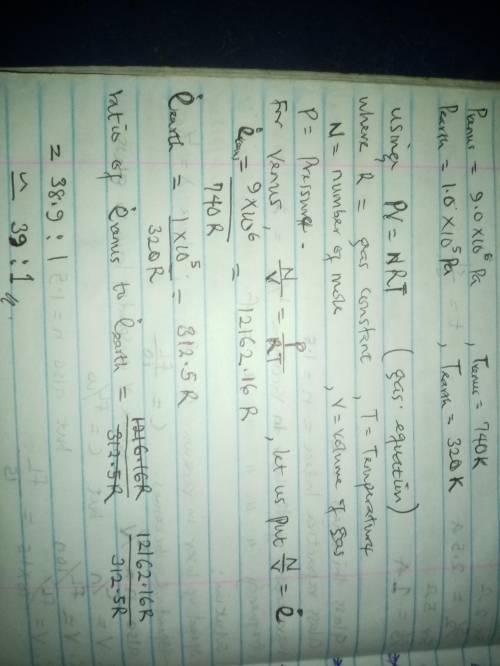
Physics, 15.04.2020 15:35 seanjung1128
On the sunlit surface of Venus, the atmospheric pressure is 9.0 106 Pa, and the temperature is 740 K. On the earth's surface the atmospheric pressure is 1.0 105 Pa, while the surface temperature can reach 320 K. These data imply that Venus has a "thicker" atmosphere at its surface than does the earth, which means that the number of molecules per unit volume (N/V) is greater on the surface of Venus than on the earth. Find the ratio (N/V)Venus / (N/V)Earth.

Answers: 2


Another question on Physics

Physics, 21.06.2019 23:30
Part a determine the magnitude of the x component of f using scalar notation. fx f x = nothing lb request answer part b determine the magnitude of the y component of f using scalar notation. fy f y = nothing lb request answer part c determine the magnitude of the z component of f using scalar notation. fz f z = nothing lb request answer provide feedback figure1 of 1a force vector acting on a ring attached to the ground is shown in the xyz space together with its x, y, and z components lying on the corresponding positive axes. the ring is located at the origin. force f is located in the first octant. f makes an angle of 60 degrees with its x component and an angle of 45 degrees with its y component. a force vector acting on a ring attached to the ground is shown in the xyz space together with its x, y, and z components lying on the corresponding positive axes. the ring is located at the origin. force f is located in the first octant. f makes an angle of 60 degrees with its x component and an angle of 45 degrees with its y component.
Answers: 2

Physics, 22.06.2019 05:30
Imagine that someone pushes one marble toward a motionless marble. would there still be action-reaction forces involved in the collision? how might the marbles’ motions be changed? ?
Answers: 1

Physics, 22.06.2019 12:10
Energy flows from the producer level to the level. is called
Answers: 1

Physics, 22.06.2019 15:40
Question 1 what is amperage? is the rate of doing work. is the rate of flow of protons in electric current. represents the amount of pressure behind electron flow. is the rate of flow of electrons in electric current. 2 points question 2 what is voltage? is the rate of doing power. represents the amount of pressure behind electron flow. is the rate of doing work. is the rate of flow of electrons in electric current. 2 points question 3 what is power? is the rate of flow of protons in electric current. is the rate of flow of electrons in electric current. is the rate of doing work. represents the amount of pressure behind electron flow. 2 points question 4 if we multiply volts times amps we get what? power circuit work current 2 points question 5 what are two ways alternating currents are similiar? in both ac and dc electrons flow in the same pattern. in both ac and dc, the flow of electrons changes directions back and forth. both ac and dc are only possible in certain materials with atoms that will allow electron flow. both ac and dc involve the flow of electrons. 4 points question 6 how does the flow of electrons flow in an alternating current? the flow of electrons is always slower in an alternating current than within a direct current. the flow of electrons is not constant and forward; it changes direction back and forth. electrons flow from from a higher affinity to that of a lower affinity. electron flow is constant and only in a forward direction. 2 points question 7 what is the flow like in a direct current? the flow of electrons is not constant and forward; it changes direction back and forth. the flow of electrons is constant and only in a forward direction. the flow of electrons go from a higher affinity to a lower affinity. the flow of electrons are always faster in a direct current. 2 points question 8 how is an electric current able to flow? electrons flow from the higher affinity to lower affinity and electrical current is generated. protons flow from the higher affinity to lower affinity and electrical current is generated. the movement of protons from one atom to another leads to an electric charge. the movement of electrons from one atom to another atom in a line results in a flow of electric current. 2 points question 9 how do electrons move from the two different types of metal in a battery? protons flow from the metal with the lower affinity to the metal with higher affinity and electrical current is generated. electrons flow from the metal with the lower affinity to the metal with higher affinity and electrical current is generated. electrons flow from the metal with the higher affinity to the metal with lower affinity and electrical current is generated. protons flow from the metal with the higher affinity to the metal with lower affinity and electrical current is generated.
Answers: 2
You know the right answer?
On the sunlit surface of Venus, the atmospheric pressure is 9.0 106 Pa, and the temperature is 740 K...
Questions

Biology, 27.05.2020 19:05


Mathematics, 27.05.2020 19:05

Mathematics, 27.05.2020 19:05

Mathematics, 27.05.2020 19:05





Mathematics, 27.05.2020 19:05

English, 27.05.2020 19:05

Social Studies, 27.05.2020 19:05

Computers and Technology, 27.05.2020 19:05




Mathematics, 27.05.2020 19:05






